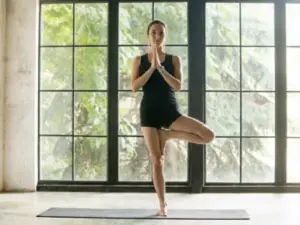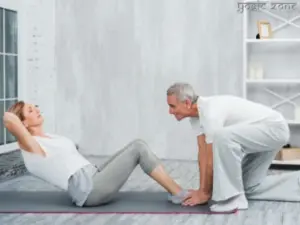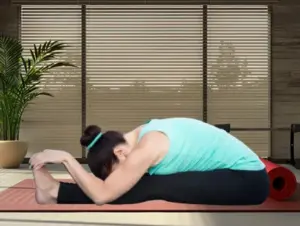
I specialise in Hatha Yoga | Prenatal Yoga | Restorative Yoga | Yoga for Marathoners | Wellness Sessions | Pranayama. I also conduct yoga retreats and workshops. Know more about Anirudh Gupta.
As a certified yoga instructor, I have had the joy of introducing restorative yoga for beginners to many people and helping them discover its many benefits. If you are feeling drained by the demands of daily life—balancing work, family, and the constant demands of modern life—then restorative yoga can be your healing space.
Unlike fast-paced yoga forms like Vinyasa or Ashtanga, restorative yoga teaches you to slow down, release effort, and rest deeply. In this guide, I will explain to you what restorative yoga for beginners is, its benefits, and how even a few minutes of this gentle practice can transform your well-being.
What Is Restorative Yoga?
Restorative yoga is a slow, meditative practice designed to activate your body’s natural “rest and digest” response. Using props such as bolsters, blankets, and blocks, it fully supports your body in comfortable postures for several minutes at a time. To know how props can help you in your practice, read our blog on yoga props for beginners.
This stillness allows your nervous system to shift into a healing state, helping reduce stress, improve sleep, and calm the mind. For beginners, seniors, or anyone recovering from fatigue or emotional strain, it’s a safe and nurturing way to reconnect with balance and self-awareness.
This is not only my personal experience but is also researched by Caroline Thompson, Janet Meller and others. Their research on third-year medical students proved that there was a reduction in stress and an improvement in the student’s ability to think.

Benefits of Restorative Yoga
The benefits of restorative yoga extend beyond physical relaxation—it nurtures the mind and spirit too.
- Deep Stress Relief: Counteracts chronic stress by lowering stress hormone levels and soothing the nervous system.
- Improves Sleep Quality: Regular practice encourages deep rest, helping those with insomnia or restless nights.
- Boosts Immunity: Calming the body helps strengthen immune function and resilience.
- Releases Chronic Tension: Holding supported asanas allows muscles to relax fully, relieving stored tightness.
- Supports Emotional Healing: The combination of stillness, gentle breath, and grounding enhances emotional balance and self-compassion.
Do you have any doubts or questions about this article?? I am Anirudh Gupta, the author, and I would love to hear from you. Send us your question now!
How to Prepare for Restorative Yoga
The beauty of restorative yoga lies in its simplicity—you don’t need strength, experience, or flexibility. Just gather a few props: bolsters, blankets, blocks, or even household items like pillows and towels. Check out our yoga props section to know about different types of props. Before you start, I recommend the following:
- Dim the lights and silence your phone.
- Light a candle or diffuse essential oils.
- Set an intention such as “I will allow myself to rest.”
This mindful setup signals your mind to move from “doing” to “receiving,” deepening the restorative experience.
What to Wear for Restorative Yoga
Comfort is key. Choose soft, breathable, layered clothing—like cotton tops, leggings, or pyjamas. Because your body cools as it relaxes, keep a shawl or light blanket handy. Warm socks or a cozy wrap enhance comfort in cool spaces. Read our blog on a guide to yoga clothes for women.
Is Restorative Yoga Difficult?
Not at all. It’s one of the most accessible and inclusive forms of yoga styles. The only challenge for many beginners is mental stillness—being present without distraction as our minds are used to constant stimulation. As your practice deepens, the quiet moments become profoundly restorative, calming your mind and spirit.
How Often Should You Practice?
Even practicing restorative yoga for beginners once a week can bring significant benefits. Your body’s needs vary—some weeks may call for more frequent sessions, especially during stressful times. The key is listening to your body’s signals with compassion rather than discipline.
Common Restorative Yoga Asanas for Deep Restoration
Here are some foundational asanas that create deep calm and rejuvenation. Also recommended by Art of Living.
| Sanskrit Name | English Name | Common Props Used | Key Benefits |
|---|---|---|---|
| Setu Bandha Sarvangasana | Supported Bridge Pose | Block under base of the spine, blanket under shoulders | Opens the chest, relieves lower back tension, and calms the mind. |
| Viparita Karani | Legs-Up-The-Wall Pose | Bolster or pillows, blanket | Soothes the nervous system, relieves leg fatigue, and aids circulation. |
| Balasana | Child’s Pose | Bolster lengthwise, blanket | Grounding and deeply relaxing; eases back and neck tension. |
| Supta Baddha Konasana | Reclined Bound Angle Pose | Bolsters or blankets under knees, eye pillow | Opens the hips and promotes restful surrender. |
| Savasana | Corpse Pose | Blanket, eye pillow, roll under knees | Facilitates total release, integration, and rejuvenation. |
Note: The asanas mentioned here are recommended by our qualified and experienced authors for general awareness and inspiration. We do not provide step-by-step instructions, as each individual’s physical condition and needs are unique. We strongly recommend learning yoga under the guidance of a qualified instructor who can offer personalised support and ensure safe practice.
The Essence of Restorative Yoga
If you have ever felt that yoga is too intense or physically demanding, restorative yoga for beginners welcomes you exactly as you are. It’s not about stretching or performing—it’s about pausing, breathing, and allowing yourself to rest.
Start with one asana; ten quiet minutes is all you need to begin your journey toward relaxation, restoration, and rejuvenation.
Do you have any doubts or questions about this article?? I am Anirudh Gupta, the author, and I would love to hear from you. Send us your question now!



